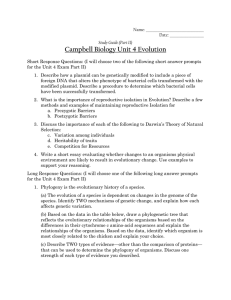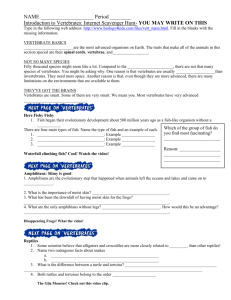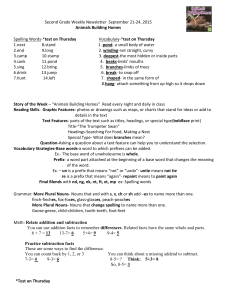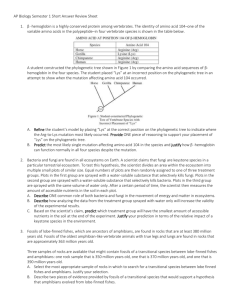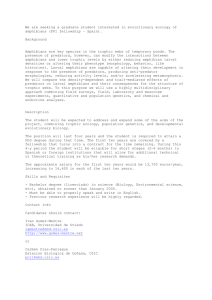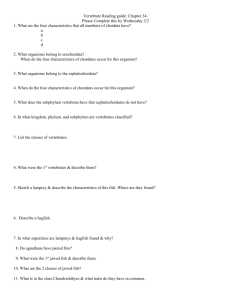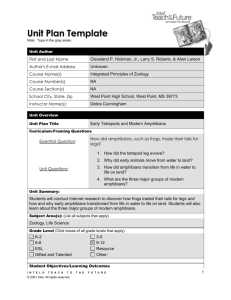amphibians-reptiles
advertisement
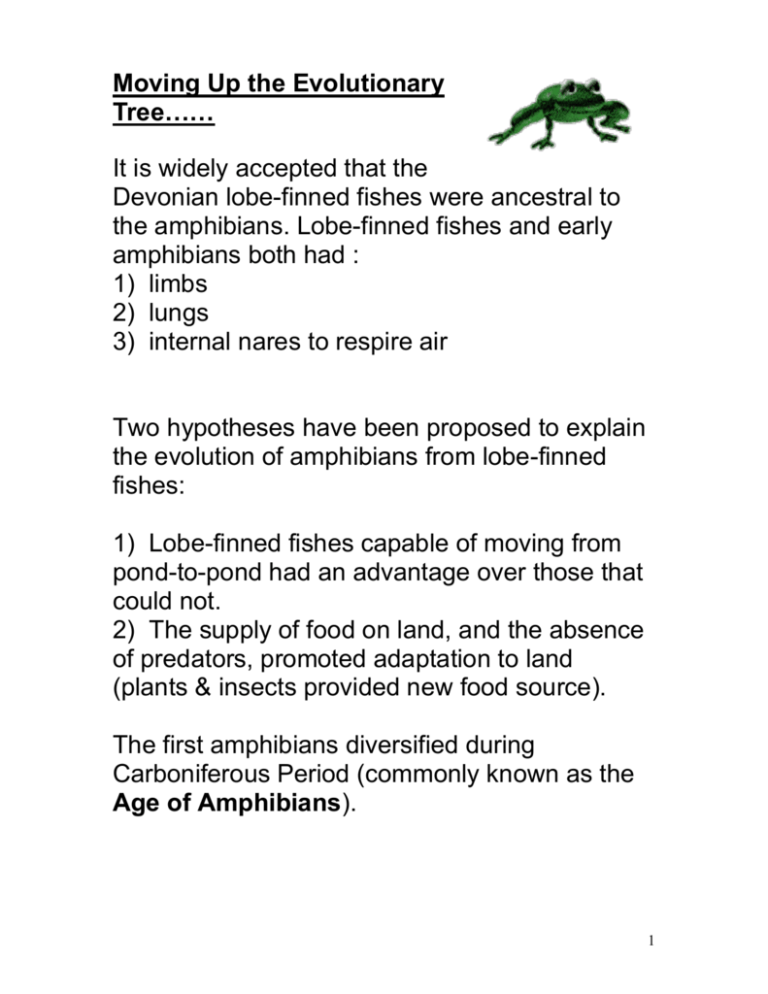
Moving Up the Evolutionary Tree…… It is widely accepted that the Devonian lobe-finned fishes were ancestral to the amphibians. Lobe-finned fishes and early amphibians both had : 1) limbs 2) lungs 3) internal nares to respire air Two hypotheses have been proposed to explain the evolution of amphibians from lobe-finned fishes: 1) Lobe-finned fishes capable of moving from pond-to-pond had an advantage over those that could not. 2) The supply of food on land, and the absence of predators, promoted adaptation to land (plants & insects provided new food source). The first amphibians diversified during Carboniferous Period (commonly known as the Age of Amphibians). 1 I. Class Amphibia about _______ species like fish, are __________; they depend upon external heat to regulate body temperatures. Amphibian features not seen in bony fish include: Limbs with girdles of _____ that are adapted for walking on land. A _______ that can be used for catching prey as well as sensory input. __________ that help keep the eyes moist. Ears adapted for detecting ______ waves moving through the thin (as compared to water) medium of the air. A larynx adapted for vocalization(males croak) A larger brain than that of fish, and a more developed cerebral cortex. Skin that is thin, smooth, non-scaly, and contains numerous ______ glands; the skin plays an active role in osmotic balance and respiration. Development of a _____ that is permanently used for gas exchange in the adult form, although some amphibians supplement lung function by exchange of gases across a porous (moist) skin. 2 A _____ double-loop circulatory system that replaces the single-loop circulatory path of fish. Development of a ____-chambered heart that pumps mixed blood before and after it has gone to the lungs. larval/juvenile stages in _____, and their adult life on land adults return to water to mate and lay eggs ________ fertilization: male clasps back of female as sperm and eggs deposited into water eggs hatch into tadpoles in about ____ days Frogs, toads, salamanders, and mud puppies are in this transitional group between water and land The evolution of the amniotic egg expanded the success of vertebrates on land amniotic egg - a reproductive adaptation that enabled terrestrial vertebrates to complete their life cycles on land and sever ties to their aquatic origins 3 protective membranes & porous shell enclosing the embryo Has 4 specialized membranes --- amnion, yolk sac, allantois, & chorion o _________ is a thin membrane surrounding a salty fluid in which the embryo "floats" o _________ encloses the yolk or protein-rich food supply for embryo o _________ stores nitrogenous wastes made by embryo until egg hatches o _________ lines the inside of the shell & regulates oxygen & carbon dioxide exchange 4 Shell leathery & ___________ _________ animals have dispensed with the shell; instead, the embryo implants in the wall of the uterus and obtains nutrients from the mother. However, the four extraembryonic membranes are retained as important structures in the development of mammalian embryos. Reptiles, birds and mammals make up a monophyletic group, the __________ 5 J. Class Reptilia represented by 7000 species first evolved during the Carboniferous time partly displaced amphibians in many environments Arose from ancestral reptile group called cotylosaurs (small, lizard like reptile) Mesozoic Era called Age of Reptiles Dinosaurs dominated life on land for 160 million years first vertebrates to make a complete transition to life on land (more food & space) Terrestrial Adaptations: dry, watertight skin covered by scales made of a protein called keratin to prevent desiccation (water loss) toes with claws to dig & climb 6 geckos have toes modified into suction cups to aid climbing snakes use scales & well developed muscular & skeletal systems to move lungs for respiration double circulation of blood through heart to increase oxygen to cells partial separation in ventricle to separate oxygenated & deoxygenated blood ectothermic - body temperature controlled by environment may bask or lie in sun to raise body temperature or seek shade to lower body temperature; known as thermoregulation water conserved as nitrogen wastes excreted in dry, paste like form of uric acid crystals 7
